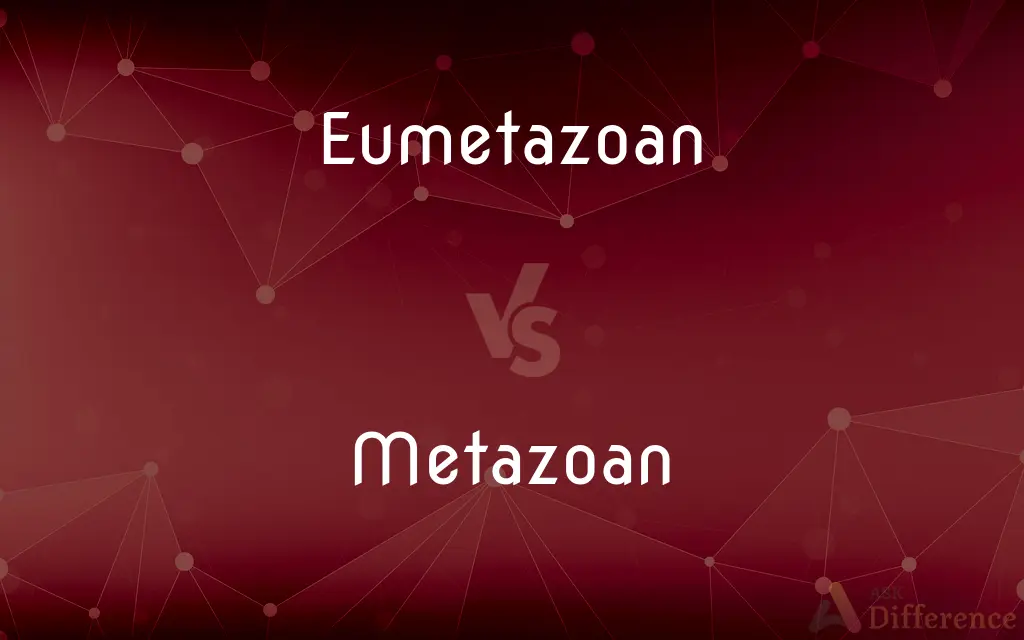Eumetazoan vs. Metazoan — What's the Difference?
By Fiza Rafique & Maham Liaqat — Updated on April 22, 2024
Eumetazoans are a subgroup of Metazoans, featuring organized tissues and symmetry; Metazoans include all multicellular animals, extending from sponges to humans.

Difference Between Eumetazoan and Metazoan
Table of Contents
ADVERTISEMENT
Key Differences
Eumetazoans, or "true animals," are characterized by having true tissues, including muscles and nerves, which allows for more complex structures and functions. Whereas, Metazoans encompass all multicellular animals, including simpler forms like sponges that lack organized tissues and organs.
Eumetazoans exhibit defined body symmetry, either radial or bilateral, which is significant for developmental patterns and behavior. On the other hand, Metazoans include species with no symmetry, such as sponges, alongside those with radial or bilateral symmetry.
In terms of evolutionary biology, Eumetazoans are considered a more derived or advanced group within Metazoans, highlighting evolutionary complexities. Metazoans, however, represent a broader basal group that includes both simpler organisms and their more complex relatives.
Reproductive strategies in Eumetazoans often involve complex systems and structures, including specialized reproductive organs. In contrast, reproduction among Metazoans can be as simple as budding or fragmentation in sponges.
The nervous system in Eumetazoans is generally well-developed, facilitating advanced sensory and motor functions. Whereas Metazoans can range from having no nervous system, as in sponges, to complex central nervous systems found in higher animals.
ADVERTISEMENT
Comparison Chart
Tissues
Organized tissues present
Tissues may be absent or present
Symmetry
Defined symmetry (radial/bilateral)
Ranges from none to bilateral
Evolutionary Complexity
More derived within Metazoans
Includes both simple and complex organisms
Reproductive Organs
Complex, specialized organs
Can range from simple to complex
Nervous System
Well-developed
Varies widely, from absent to complex
Compare with Definitions
Eumetazoan
Belongs to a subset of the animal kingdom that excludes the simplest forms.
Unlike sponges, Eumetazoans have tissues that form organs.
Metazoan
May exhibit any type of body symmetry, or none at all.
While some Metazoans are asymmetrical, others like humans have bilateral symmetry.
Eumetazoan
Exhibits either radial or bilateral body symmetry.
Starfish are radially symmetrical Eumetazoans.
Metazoan
Any multicellular animal ranging from sponges to vertebrates.
Sponges are simple Metazoans without organized tissues.
Eumetazoan
Typically possesses a nervous system and sensory organs.
Eumetazoans like dogs have complex sensory systems.
Metazoan
Includes the broadest categories of animals in the animal kingdom.
Metazoans encompass both jellyfish and elephants.
Eumetazoan
A multicellular animal with organized tissues and symmetry.
Jellyfish and humans are examples of Eumetazoans.
Metazoan
Nervous system presence varies from none to highly complex.
While octopuses have sophisticated nervous systems, sponges do not.
Eumetazoan
(zoology) Any animal of the subkingdom Eumetazoa (all animals except sponges)
Metazoan
Any of numerous heterotrophic eukaryotic organisms of the kingdom Metazoa, characteristically having a multicellular body with cells differentiated into tissues; an animal.
Metazoan
Any animal that undergoes development from an embryo stage with two or three tissue layers, namely the ectoderm, endoderm, and sometimes mesoderm.
Metazoan
(zoology) Any animal that is multicellular.
Metazoan
Having to do with animals that develop from an embryo with three tissue layers.
Metazoan
Having to do with animals that are multicellular.
Metazoan
One of the Metazoa.
Metazoan
Any animal of the subkingdom Metazoa; all animals except protozoans and sponges
Common Curiosities
Can Metazoans be asymmetrical?
Yes, some Metazoans like sponges are asymmetrical.
Are all animals Metazoans?
Yes, all multicellular animals are classified as Metazoans.
Do Eumetazoans have a nervous system?
Yes, Eumetazoans typically have a well-developed nervous system.
Is a jellyfish an Eumetazoan or a Metazoan?
A jellyfish is both a Metazoan and an Eumetazoan.
What is the difference in reproductive systems between Eumetazoans and Metazoans?
Eumetazoans have complex, specialized reproductive organs, while Metazoan reproduction can range from simple to complex.
What types of organisms are included in Metazoans?
Metazoans include all multicellular animals, from sponges to mammals.
What defines an Eumetazoan?
Eumetazoans are defined by the presence of organized tissues and symmetry.
Are sponges considered Eumetazoans?
No, sponges are Metazoans but not Eumetazoans, as they lack organized tissues.
How do Eumetazoans differ in symmetry from Metazoans?
Eumetazoans exhibit defined radial or bilateral symmetry, whereas Metazoan symmetry varies widely.
What evolutionary advantages do Eumetazoans have?
Eumetazoans possess evolutionary advantages like complex organ systems and structured reproductive strategies.
How does the nervous system vary between Metazoans and Eumetazoans?
Eumetazoans generally have a more complex nervous system compared to the simpler or absent systems in some Metazoans.
Do all Eumetazoans have bilateral symmetry?
No, Eumetazoans can have either radial or bilateral symmetry.
What are the simplest forms of Metazoans?
The simplest forms are sponges, which lack organized tissues and organs.
Which is a more inclusive category, Metazoan or Eumetazoan?
Metazoan is the more inclusive category, encompassing all multicellular animals.
Share Your Discovery

Previous Comparison
Front vs. Frontside
Next Comparison
Idea vs. ThemeAuthor Spotlight
Written by
Fiza RafiqueFiza Rafique is a skilled content writer at AskDifference.com, where she meticulously refines and enhances written pieces. Drawing from her vast editorial expertise, Fiza ensures clarity, accuracy, and precision in every article. Passionate about language, she continually seeks to elevate the quality of content for readers worldwide.
Co-written by
Maham Liaqat













































